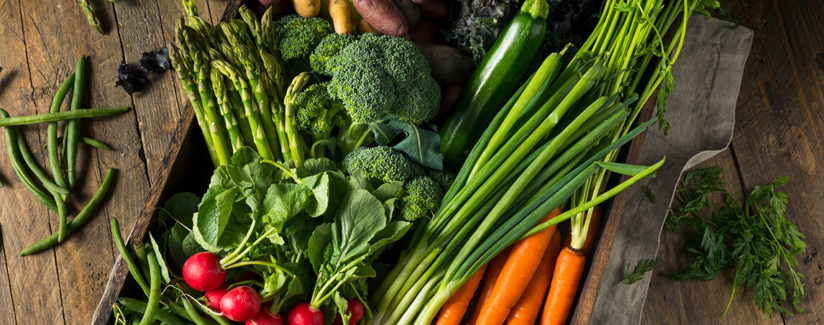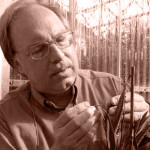
Are Pesticides Safe for Food Consumption?
01/31/2019
Food safety is an important issue and there have been conversations about food safety and pesticide use. We’re taking a look at some questions about pesticides Are Pesticides Needed to Grow Food? Are Pesticides Safe for the Environment? What’s the Difference Between Pesticide-Free and Organic?
Is food that is grown using pesticides safe to eat? We got in touch with three scientists to ask them about pesticides and food safety. Dr. William Vencill is a Professor of Crop and Soil Sciences, University of Georgia; Jeff Graybill is an Extension Educator in Agronomy, Penn State University; and Dr. Stephen Baenziger is a Professor of Plant Sciences, University of Nebraska.
The experts all pointed out that pesticides, because they do involve an amount of risk, are very closely regulated by government agencies to make sure food is safe.
“Since these chemicals are designed to kill a specific weed or pest, they must be respected, so when looking at human and animal health implications, regulatory agencies have very stringent standards,” Mr. Graybill noted. “Any pesticide that comes to market must be approved and certified by the EPA, USDA and FDA. Toxicology data is peer reviewed and is combed over very intensely. The government agencies then make a determination if there are any negative impacts and whether those negative impacts are outweighed by the good that the chemical will do.”
Pesticides have been used in some form for thousands of years, dating back to the ancient Romans. Synthetic compounds were developed in the 1940s. Over the course of time, these chemicals have undergone extensive testing. Some of those that were determined to be less safe have been removed from the market. Each year, the FDA tests many samples of food to determine if they have unsafe levels of pesticide present.
Even though the presence of a pesticide may be detected, that does not mean that it would have an effect on humans, Dr. Vencill said.
“A misconception is that pesticides at any level are bad for you,” he said. Sometimes, pesticides make a food safer by removing fungus that can be toxic to humans.
Check out these detailed answers from the experts to address questions about pesticides and food safety.
Are pesticides safe for food consumption?
Vencill: “I would say that nothing is totally safe – there is a risk to whatever we do and this applies to pesticide residues in food. Pesticides are rigorously tested for short-term and long-term health impact by the EPA and other regulatory bodies around the world. They weigh the risks against the benefits of a pesticide in question. In this risk analysis, safety factors of 100 to 1,000-fold are built in to the levels of pesticide residues that could cause harm with a calculated exposure of 70 years.
“So, when a person sees a media report that some group has discovered the presence of a pesticide in a given food product, a couple of things need to be considered. Presence does not equal danger. Analytical chemists are now able to identify pesticide residues at levels far below any possible concentration that has been shown to cause harm.”
Graybill: The United States has an extensive regulatory system, and whether it’s household chemicals or agricultural herbicides and insecticides, all chemicals go through extensive toxicology testing to look at the benefits and the risks of the product. This is especially true of pesticides used on food crops.
“Since these chemicals are designed to kill a specific weed or pest, they must be respected, so when looking at human and animal health implications, regulatory agencies have very stringent standards. Any pesticide that comes to market must be approved and certified by the EPA, USDA and FDA. Toxicology data is peer reviewed and is combed over very intensely. The government agencies then make a determination if there are any negative impacts and whether those negative impacts are outweighed by the good that the chemical will do.”
Baenziger: “Clearly, some levels of pesticides would be toxic to humans, but at low levels they are safe to consume. Also, keep in mind that plants naturally produce many chemicals to protect themselves from the effects and damages caused by insects and pathogens. We have eaten these “natural” pesticides for millennia and foods containing these compounds. If the natural pesticides or the applied synthetic pesticides are known to be harmful to humans, they are monitored and checked before the food product can be sold.”
How long have pesticides been used by farmers … can you give us a brief history of pesticide usage?
Vencill: “In some forms, pesticides have been used for thousands of years. The ancient Romans used table salt as a pesticide. In the 19th century, many farmers used inorganic salts such as copper and sulfur as pesticides for plant pathogen control. These materials are still used and can be used for certified organic foods.
“The use of synthetic compounds for pesticides really began in the 1940s. A number of halogenated chlorine insecticides such as DDT were used for insect control. Around this same time, 2,4-D, a different molecule, was introduced. It was the first compound that could kill weeds without harming crops (known as selective herbicides).”
In fact, 2,4-D is still used today because it continues to meet all safety standards that have been established by regulatory agencies. It has been studied extensively and approved by more than 90 counties.
“Throughout the 1960s, a number of herbicides that are still the standard of weed control in some systems were introduced (atrazine for weed control in corn, metolachlor in corn and soybean, the dinitroanilines in a number of crops). These materials were typically soil applied at 1-to-4 pounds of product per acre. In the early 1980s, we saw a revolution of sorts in the herbicide world as materials were introduced for weed control that could be applied at very low rates. Since the 1980s, most new herbicide introductions have been low-dose herbicides. The next revolution came in the mid-‘90s with the introduction of glyphosate-resistant, commonly called “Roundup Ready” crops due to the first product name for glyphosate. By the mid-2000s, greater than 90 percent of corn, soybean, and cotton were glyphosate-resistant.”
Graybill: “Modern agricultural chemicals began to be used in the mid to late 1960s. Many products have a long track record of safety, while the more toxic ones have been weeded out and replaced with new products which are less dangerous to humans and the environment.”
Baenziger: “Pesticides have a long history of use. Most people think of synthetic pesticides of the 1940s and thereafter. However, Bordeaux Mixture, a fungicide containing copper sulphate and lime, has been used on grapes for hundreds of years. Copper can be a detriment or pollutant to the environment.”
What are some common misconceptions about how pesticides effect food safety?
Vencill: “One misconception is that we can have a food supply with zero risk of harm. There are natural pesticides in plant products that are present, but usually cause minimal risk. Since they are natural, most people do not think about them. A corollary to this is that the presence of a compound equals danger. If a pesticide is found, at what level to approved residue levels were present?
“Another misconception is that some pesticides are not regulated. All pesticides used in the U.S. are regulated. Finally, there is a misconception that organically certified products do not have pesticide residues. They do; they are just from a different list.”
Graybill: “Many people don’t realize that pesticides can actually increase the quality of foods. This is because they will control the diseases and insects which can destroy a crop or cause it to become rotten. When crops have less disease and insect damage they can be stored longer and shipped longer distances, giving us a great variety of food products to choose from.”
Baenziger: “Some believe if a pesticide is toxic to an insect, weed or disease, it must also be toxic to humanity. Some pesticides affect one or a few organisms, but not humans. Another misconception is that pesticides at any level are bad for you and that the effect of pesticides on human health are greater than would be the effects of the insects or fungus they are meant to control. For example, some plant fungal pathogens produce very high levels of toxins if they are not controlled. Fungicides actually control some fungi and prevent them from making very severe health-affecting chemical products such as mycotoxins. The presence of mycotoxins is strictly monitored and must be lower than a well-defined level for the crop to be sold legally or ethically into the food system.”
What safeguards are in place to ensure people are not consuming unsafe levels of pesticides?
Vencill: “All pesticides are rigorously evaluated for their potential impact on human health. Any compound that shows a potential for harm is pulled from development and commercialization is stopped. Regulatory agencies determine the safe levels of residues in all food products. These residue levels have 100 and 1,000-fold safety factors built-in. Furthermore, the FDA regularly conducts market surveys of food products where they purchase food products from a grocery store and analyze for a wide range of pesticide residues. These market basket surveys do show some food products that contain pesticide residues, but they are usually below any residue limit which could cause harm to people.”
Graybill: “All pesticides used in farming have strict labels with instructions on their use. The label is actually the law. It’s a legal document which, if violated, the farmer can incur a fine or other punishment. Also, farmers must have training and a pesticide license in order to apply pesticides. This shows that they are knowledgeable about the risks and benefits of pesticides and how to use them safely for their own farm family and for their customers.”
Baenziger: “Imported foods and domestic food markets are heavily monitored to ensure everyone has a safe food supply.”
What’s your advice to people who would rather not purchase food from producers who use pesticides?
Vencill: “One beauty of our free-market system is that foods that claim to be pesticide free are available to those who can afford them. However, I feel it is unjust to try to impose that view on others in the U.S. and worldwide because of the potential to deprive people of access to what I think is the healthiest and safest food supply in the history of humanity.
“A diet with a variety of fruits and vegetables is considered the healthiest. Many people cannot afford to buy organic produce and to spread opinion that consuming traditional food products is not safe because of pesticides is troublesome. It can cause those without the means to purchase other processed food products that are probably less healthy. For developing countries, limiting the food supply because of narrow choices can lead to starvation.”
Graybill: “You can purchase USDA certified organic if you have specific concerns. These products are monitored to ensure that they were grown without synthetic pesticides. Many will, however, have been sprayed with ‘organically certified natural pesticides’.”
Baenziger: “People are free to buy regulated organic food products, but that is a choice. A perceived need to purchase organic food for food safety reasons is not based on science.”
Summary
Pesticides used on crops are closely regulated in the United States to make sure the food supply is safe. Samples are routinely tested to make sure no chemicals are present at unsafe levels on the food we eat. Food that is certified organic is raised without synthetic pesticides, but may be raised with organically certified pesticides.
Other articles in this series:
Are Pesticides Needed to Grow Food?




























